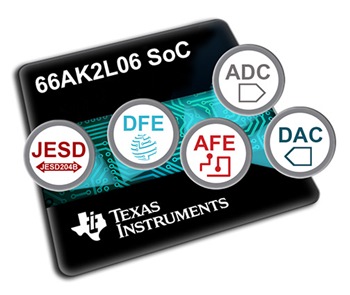SSZTCR3 may 2015 66AK2L06
The past few years have seen a sea change in terms of wireless technology. A few years back if someone pictured a basestation, images of a mast with multiple antennas and a labyrinth of wires running into a dusty, mysterious shed would come to mind. While, some of that stays true even today, we now have technology which enables that same wireless access to be delivered through much smaller and less cumbersome solutions. This “small cell” technology, as it’s called, can now enable service parity with macro coverage both indoors and outdoors.
This advent of technology combined with the widespread acceptance of LTE as the mainstream wireless technology of the future, has spawned various verte in these applications, each of these markets drive very unical market segments such as special purpose basestations to be used in military/public safety networks, transportation, etc. The portable and small form factor of these basestations allows deployment in adverse and remote geographic conditions on the ground, offshore oil and gas rigs, and now even in very high altitude aerial deployments to provide connectivity where macro base transceiver station (BTS) are either not possible or commercially unviable.
While the base technology remains the same in these applications, each of these markets drive very unique requirements and use cases that test the flexibility and performance of the solution (baseband and RF). After the launch of our most integrated small cell SoC (TCI6630XX), we saw a significant uptick in interest for that solution from various customers who wanted to address these unique requirements for these markets. The other competing solutions available were either too power hungry (FPGAs) or were ‘black box’ solutions, thereby being too restrictive in there usage for these markets. We also saw customers from non-wireless segments emerge with similar needs in applications such as radar, test and measurement, avionics, medical applications and other high-speed data generation and acquisition markets.
Seeing this interest and potential, it was time for us to go back to the drawing board to evolve our roadmap further. The task we undertook was to make this technology simpler and more accessible by coming up with solutions which:
- Enable customer flexibility and differentiation for example, low-level Layer 1 changes to allow longer than usual range, radius than what’s seen for small cells
- Enable customers in both wireless and non-wireless markets to choose from a variety of integrated RF/analog-to-digital-converter (ADC)/digital-to-analog-converter (DAC)combinations
- Enable customers to develop rapidly and focus on differentiation, rather than spend time tuning the system for basic functionality with ADC/DACs
- Provide tools for customers to program at higher level languages like C/C++ vs. worrying about register-transfer level code
- Provide customers an ecosystem of expertise which allows them to partner up with various vendors of hardware and software to meet there time-to-market and product goals
The results of our work over the past few months is now available in the market as we launch the 66AK2L06 device combined with TI Designs providing customers a software API to control and be able to configure RF solutions. Additionally, we launched our ecosystem of vendors who will work with customers to get their end products to market quickly and efficiently.

We believe the applicability of this technology is widespread and it can go a long way in making the world more connected and capable. Our journey is just beginning!!